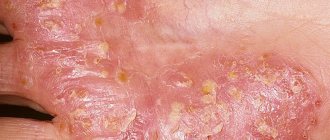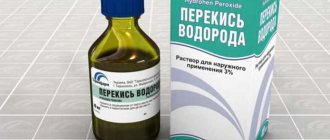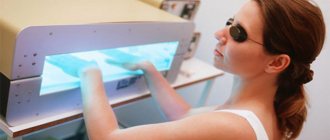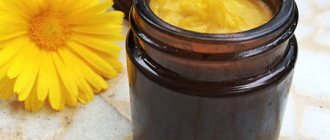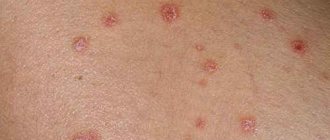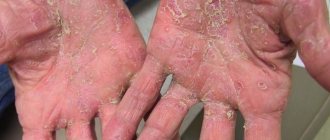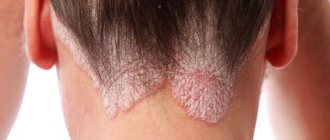Psoriasis of the scalp is a skin disease characterized by the formation of numerous scales on the surface of the dermis. This type of psoriasis is quite common. All patients are forced to experience serious discomfort from time to time and are constantly in search of the most effective treatment methods.
If treatment for psoriasis on the scalp is not started in time, a person risks facing serious complications. It is very important to start taking medications in a timely manner, and in the initial stages it is permissible to use traditional methods of treatment.
Features of the disease
The head is one of the most common areas of localization of psoriasis. In the initial stages, plaques appear exclusively on the skin of this part of the body. However, in the absence of timely treatment, the damage spreads to nearby areas.
Psoriasis of the scalp is complicated by the fact that the skin in this area has a special structure. It is subject to constant contact and microtrauma that occurs during combing.
Statistics show that 1% of the world's population suffers from this disease. Keep in mind that psoriasis of the scalp can be complicated: the damage spreads to nearby areas of the skin, and even internal organs and joints.
Most often, women aged 20-25 years experience this disease. People whose relatives suffer from dermatological diseases are also at increased risk. In this case, more serious treatment is prescribed.
How should you care for your hair?
If a person has been diagnosed with pilaris psoriasis, he needs to learn how to properly care for this area. In the event that patients follow all the recommendations of specialists, they will be able to achieve good results in the therapy process:
- The scalp should be washed only with special shampoos.
- When combing your hair, you must use combs with bristles made from natural materials. Manipulations should be carried out very carefully so as not to injure psoriatic plaques, otherwise they may become infected.
- Every day, patients must sanitize all instruments used for personal hygiene.
- Dermatologists do not advise such patients to use hair dryers, dye their hair, or get perms, as such actions can lead to additional damage to the skin.
- If the disease is severe, then the ideal solution would be a short haircut, which will greatly facilitate both external treatment of the skin with medications and hair care.
- In cases where patients do not want to give up long hair, they are not recommended to tie it with elastic bands and do complex hairstyles.
Causes
The main reason for the development of psoriasis on the scalp is metabolic disorders. Due to specific reactions to irritants, the body begins to rapidly divide dermal cells. Normally, the skin is renewed in 3 weeks, and during an exacerbation of this disease - in 5 days. Because of this, numerous scales appear on a person’s head.
Over time, the lesions unite with each other, which causes the person even more discomfort. It is only possible to say unambiguously whether psoriasis on the scalp can be cured if you know its cause. The following factors can provoke an exacerbation:
- skin injury;
- stress and emotional overstrain;
- hormonal imbalances;
- diseases of the endocrine system;
- disturbances in the gastrointestinal tract;
- smoking and drinking alcoholic beverages;
- infectious processes in the body;
- improper and unbalanced diet;
- use of certain medications;
- hypothermia or prolonged exposure to cold;
- genetic predisposition;
- use of low-quality care products.
The greatest danger is represented by psoriasis on the head of a child. In this case, drug treatment should be prescribed exclusively by a doctor.
How to treat psoriasis on the head in a hospital and at home
All medications for psoriasis are usually divided into two categories: external and internal. Using them you can forget about the disease forever. As a rule, the use of external medications is not always possible due to constant hair growth, so special balms and shampoos are replacing various ointments.
Not everyone knows how to treat psoriasis on the scalp, especially when encountering the disease for the first time. But most internal medications are hormonal.
In the case of drug treatment, various medications with restorative and sedative effects are often used. These can be such well-known vitamin complexes as Pyrogenal or Pikaminlon, which are based on folic and nicotinic acids. Treatment of the disease in a hospital is mainly carried out in cases where severe or moderate psoriasis manifests itself. Specific treatment methods and medications are prescribed based on the stage of the disease: stationary, progressive or regressive.
At the stage when treatment in the clinic is necessary, patients no longer have time to hesitate; active measures begin to relieve inflammation and disinfection.
In addition to the standard set of injections and a wide variety of tablets, external preparations, such as lotions and ointments, are used. After the disease enters the next stage—the time of regression—the patient is discharged for further treatment at home. The course of treatment usually takes two weeks. And the doctor will have to tell you how to treat psoriasis on the head at home when you leave the hospital.
Treatment at home
To date, there are no medications that could help permanently get rid of a disease such as psoriasis. The main goal of home treatment is primarily to control its development.
The increase in the time period of the remission stage occurs due to the use of the listed funds:
- Special shampoos.
- Medicinal ointments.
- Infusions of various herbs.
- Baths with the addition of herbal infusions.
- UV irradiation.
When prescribing home treatment, it is important to know several rules that must be followed:
- You will need to take all prescribed medications regularly.
- In the absence of severe symptoms, it is enough to use products containing aloe vera. Only in case of severe disease is it necessary to switch to the use of any hormonal drugs.
- Using the prescribed creams, you will be able to maintain a normal level of skin moisture.
- In the case of sunbathing and the recently popular UV therapy procedure, it is imperative to strictly follow the schedule suggested by the doctor.
- To get rid of various manifestations of the disease, it is advisable to use the most ordinary means. Most doctors agree: it is undesirable to use several different ointments and preparations at the same time, since it will be impossible to determine how effective a particular remedy was for you.
- During treatment it is necessary to take a break. Moreover, the average break time between courses varies from several weeks to six months.
- If psoriasis is noticed in a child, then it is necessary to pay attention to the factors that provoked the disease in order to eliminate them as soon as possible. In this case, it is usually enough to follow a diet.
Varieties
Most often, recognizing the signs of psoriasis of the scalp, the treatment of which requires an integrated approach, is very simple. It is enough to look at the raised inflamed areas of the dermis. They appear as greyish-white scales that come off easily. If they are removed from the surface of the dermis, a bleeding wound remains, which causes serious discomfort to the person. At the moment, the following varieties are distinguished:
- Psoriatic – numerous plaques appear on the skin, which quickly grow and unite with each other. The most common form of the disease.
- Drop-shaped - occurs as a consequence of streptococcal infection. Raised reddish drops appear on the head, shaped like drops or teardrops.
- Pustular - most often spreads in the back of the head; it can be recognized by the resulting blisters, which are filled with clear liquid inside.
Psoriatic plaques require constant care, as if infected they can cause the formation of pustules.
What does it look like and reasons?
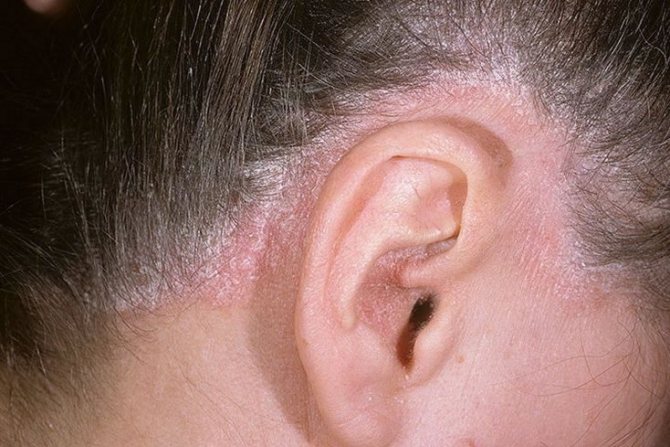
When the scalp is affected by psoriasis, hair loss does not occur, as is possible with simple dandruff. However, psoriasis itself can eventually develop into erythroderma, which leads to hair loss. However, there is still one negative effect of the disease on the structure of the hair: the hair becomes significantly thinner in places where plaques form. Depending on the form of psoriasis, plaques may have thin scales, and the lesions are minimal. If the form is too severe, external signs are more significant. Often, psoriasis rashes, in addition to the scalp, can be localized on the earlobes, in the neck, in particular in the back of the head, and even in the area of the ears.
If the disease is really severe, then the plaques may become weeping, which causes noticeable discomfort. Symptoms of this type of plaque appear in the form of cracks in the skin, which can cause pain even against the background of incessant itching.
An important point in the treatment of the disease is the correct identification of the cause, since usually its elimination leads to a decrease in the symptoms of the disease as a whole. Officially, there is a certain group of factors that lead to the appearance of this disease.
- A predisposition at the genetic level, which can be inherited and at the same time not make itself felt for a long time.
- Autoimmune processes are when the immune system begins to damage the body's own cells.
- Immunodeficiency processes caused by various serious diseases, for example, AIDS.
- Diseases at the hormonal level, since disruption of this background leads to a malfunction of the endocrine system.
- The presence of allergic reactions also leads to the formation of psoriasis plaques.
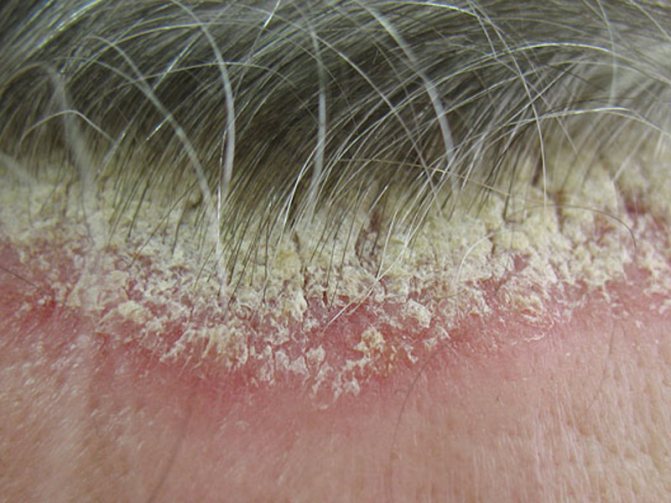
These reasons are direct indicators that the disease will appear in the body. However, doctors also offer a list of so-called provocateurs, the action of which can lead to further attacks of the disease.
- The use of steroids and hormonal drugs, which, however, are often prescribed by a doctor for treatment purposes.
- Exposure to ultraviolet rays, particularly from solarium use. Uncontrolled tanning ultimately leads to burns on the skin, which can serve as an impetus for the formation of psoriasis plaques.
- Stress that becomes chronic due to its severity, improper daily routine, unbalanced diet and fatigue.
- Inflammatory processes that have become chronic, for example, too frequent sore throats or flu, which is accompanied by fever.
Symptoms
Recognizing the signs of psoriasis on the scalp is quite simple. Already in the initial stages, pinkish rashes appear on the surface of the skin: they have a round shape, covered with numerous whitish scales on top. They quickly grow in size, and compacted itchy plaques form. When diagnosing this disease, the following features must be taken into account:
- in the initial stages, patients may complain of general malaise, weakness, increased body temperature;
- the skin becomes more sensitive and painful, and over time becomes covered with flaky scales;
- after this, itching and burning appears, a powerful inflammatory process forms;
- when scratching, the dermis becomes covered with bleeding abrasions and cracks;
- God becomes denser, coarsens;
- plaques begin to peel off, causing huge layers to appear in the hair, somewhat reminiscent of dandruff;
- treatment with external means does not bring any results;
- the itching grows, the person cannot do his usual activities;
- the skin loses its firmness and elasticity, becomes susceptible to injury and wounds;
- prolonged absence of treatment leads to the spread of pathology throughout the head and other parts of the body;
- all this is accompanied by aesthetic discomfort, a person can easily fall into depression.
Folk recipes
When carrying out complex therapy for hairy psoriasis, patients can simultaneously use “old-fashioned” methods. To choose the most effective and safe recipe for yourself, each patient should consult with their dermatologist.
The following healing agents can help in the fight against this incurable disease:
- Celandine grass (300g) is collected, which is necessarily washed, dried and crushed. From the resulting slurry, it is necessary to squeeze out the liquid, to which dry red wine (30 ml) is added. The affected areas of the skin should be treated with this composition, leave it for 15-17 minutes, then rinse thoroughly under running water.
- You need to prepare a tincture from young sunflower baskets (2 pieces): they are crushed and poured with white wine (100 ml). The container is closed and stored in a dark place for two days. After this, the juice is squeezed out of the mixture. This healing liquid should be used to treat the lesions. This recipe is ideal for those patients whose psoriatic manifestations are accompanied by inflammation.
- Elderberry inflorescences (1 tbsp) are collected, placed in a container and filled with boiling water (450 ml). The contents of the dish should sit for at least one and a half hours. After this, the mixture is filtered, and the healing solution is consumed an hour after meals, half a glass.
- Natural honey (1 tbsp) is placed in a bowl, to which protein (1 pc) and a small amount of shampoo (for children) are added. All components are thoroughly mixed and then applied to the affected areas. After 25 minutes, the product should be washed off under running water.
Drug treatment
If you do not know how to get rid of psoriasis on the scalp, be sure to consult your doctor. It will help you choose the most effective treatment regimen. Conventional treatment for this disease involves the use of the following:
| Group of drugs | Examples |
| Sedatives | Valerian, tincture of hawthorn or motherwort. |
| Antihistamines | Erius, Pipolfen, Tavegil. |
| Hyposensitizing | Diphenhydramine, Peritol. |
| Antibiotics | Amoxicillin, Amoxiclav. |
| Immunomodulators | Leakadin, Taktivin, Dekaris. |
| Cytostatics | Methotrexate, Cyclosporine. |
| Glucocorticosteroids | Prednisolone, Dexamethasone. |
| Aromatic retinoids | Etretinate, Acitretin. |
| Diuretics | Furosemide, Spironolactone. |
| Anti-inflammatory | Ibuprofen, Diclofenac. |
| Antidepressants | Heptor, Amirol. |
| General strengthening | Vitamin C, Echinacea. |
| Ointments for psoriasis on the head | Zinc, Salicylic ointments. |
To get rid of diathesis, diuretics are prescribed. They help remove excess fluid from the body, which contains toxins and waste. Anti-inflammatory drugs are also prescribed to alleviate the course of the disease. With their help, it is also possible to minimize the likelihood of developing psoriatic arthritis. If a person does not experience relief for a long time, pyrotherapy is prescribed.
To reduce the symptoms of itching and burning, sedatives and antihistamines are prescribed. If the discomfort is unbearable, tranquilizers are prescribed. In complicated situations, cytostatics and corticosteroids are also prescribed, which alleviate the course of the disease. Please note that only doctors can prescribe them, as improper use can lead to serious complications. Ointment for psoriasis on the head will help quickly relieve discomfort. With it, treatment of the disease will be quick.
Many doctors, if they are asked how to cure psoriasis on the scalp, always say that it is necessary to use antibiotics. However, their use is justified only if there is an infectious infection of the skin. To get rid of anxiety and depressive moods, it is enough to start taking psychotropic drugs. To improve metabolic processes, vitamins are used. Keep in mind that no remedy for scalp psoriasis can completely cure this disease.
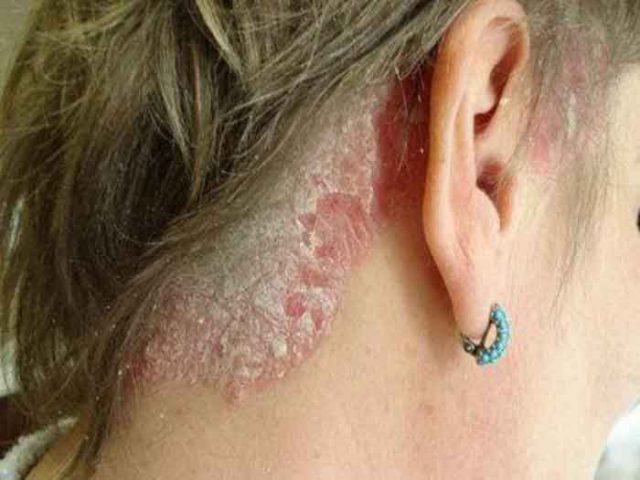
How and with what to treat psoriatic plaques
Traditional methods of treating scalp psoriasis are divided into four main stages:
- The use of medicines based on salicylic acid or urea to clean the affected areas of scales.
- The use of vitamin D analogues, antifungals, corticosteroids, systemic treatment and phototherapy for the cleansing process.
- Stabilization of the condition and gradual reduction in the dosage of potent drugs, and then their complete replacement with weaker ones.
- Regular hair care using mild detergents.
After completing all stages of treatment, you will need to adhere to this throughout your life.
Home treatment methods also have their own characteristics; their use requires compliance with certain rules to achieve the desired result:
- More effective treatment can be achieved using several traditional methods simultaneously.
- Traditional medicine also has a certain course of treatment that must be followed to achieve positive results. The duration of therapy depends on the chosen method.
- When treating with folk remedies, it is necessary to follow all the doctor’s recommendations: combined use of medications with traditional therapy, protecting the skin from direct sunlight and temperature influences, following a special diet, and so on.
Before applying and rubbing healing masks into the affected areas of the skin, it is necessary to cleanse the body. Regardless of the form of psoriasis, a large amount of toxins and waste accumulates inside the body, and psoriatic plaques that appear on skin areas are an external manifestation of intoxication.
Traditional recipes for cleansing the liver and blood:
- Rosehip decoction. To prepare, you need to take five tablespoons of dried rose hips, put them in a container and pour a liter of boiled water. Next, put everything in a thermos and leave for 10 hours. Drink about 100 grams of this product in the morning and evening for seven days.
- A decoction of flaxseeds. To make it, you will need one tablespoon of seeds, placed in a thermos and filled with 100 milliliters of boiling water. This remedy must be drunk once a day, preferably in the morning on an empty stomach, for 7 days.
- Collection of medicinal herbs. To prepare the following decoction you need the following ingredients: celandine, mint, plantain. All components must be mixed in equal parts and placed in a container, then pour 0.5 liters of hot water over everything and leave for two hours. Next, you will need to strain the product and it is recommended to use 50 milliliters of it between meals.
Quite a large number of doctors prescribe the use of traditional medicine at a time when the disease is in remission, however, in some cases, such remedies can also be used during an exacerbation.
Traditional treatment methods
Many people actively use folk remedies for scalp psoriasis to combat this disease. Keep in mind that such treatment methods are effective only in the initial stages of this disease. Various oils are used: peanut, mineral, coconut, olive, rosemary and others. They can be rubbed into the skin in pure form or as a mixture before bed, leaving overnight. In this case, the oil must be washed off with medicated shampoo in the morning.
Onion juice, clay, and nettle decoction will help improve the condition of the skin. You can also prepare the following medicine: take coconut oil and natural honey in equal proportions. To make the product smell more pleasant, you can add a few drops of essential oils to the mixture. Heat the resulting medicine in a water bath, then rub it into the scalp.
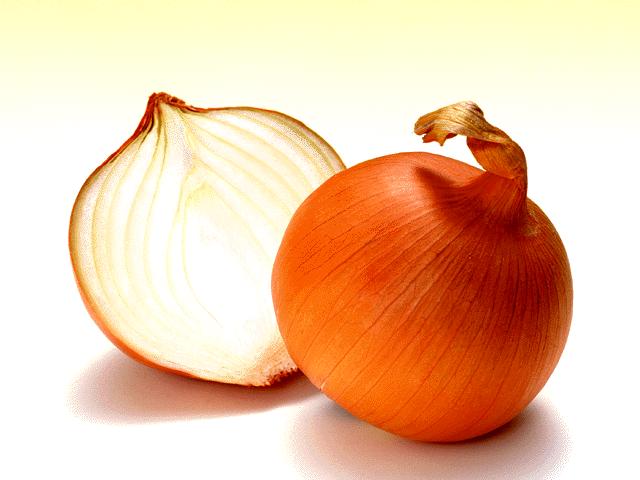
There are a huge number of remedies for the treatment of psoriasis on the head, but not all are able to help you alleviate the course of the disease. It is best to use them in the initial stages of the disease, because in more advanced forms they will not bring any results. Regular sea salt will help get rid of inflammation and itching. It must be rubbed into the head once a day. For easier application, you can mix the salt with rose or eucalyptus essential oil.
Forms of the disease
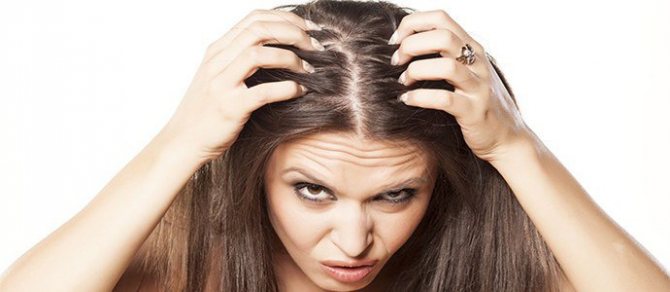
Hairy psoriasis can occur in two forms:
- Easy. In people, single lesions that are small in size appear on the scalp. The surface of psoriatic plaques is covered with small scales.
- Heavy. In humans, the skin is completely affected. On the scalp there is a large accumulation of psoriatic plaques, which are large in size, have a dense structure and large scales.
Modern medicine distinguishes several stages of development of this skin pathology:
- Stationary. During the development of the disease, patients do not develop new psoriatic plaques, but the old rashes do not disappear.
- Progressive. At this stage, in people, existing psoriatic plaques move beyond the scalp and affect the frontal area, ears, neck area, etc. At the same time, new rashes join them, and symptoms intensify.
- Regressive. In patients at this stage of the disease, characteristic symptoms begin to gradually disappear. Pigment spots form in place of psoriatic plaques.
Psoriasis pilaris is a skin pathology that is diagnosed in almost 60% of people who contact dermatologists with complaints about the manifestation of characteristic symptoms. If the disease is not treated promptly, people will have to face serious complications.
As a rule, with this form of the disease, psoriatic plaques are localized in the following areas:
- The skin located above and behind the ears is affected. The lesions spread to the lobes.
- The occipital part and frontal area are covered with psoriatic plaques.
- The skin on the back of the neck is affected.
- Psoriatic rashes are localized in the partings between the hair.
Medicinal shampoos
Treatment of psoriasis on the scalp at home involves the mandatory use of shampoos. With their help, you can quickly get rid of itching, burning and stop the growth of psoriatic plaques. Keep in mind that their therapy must be accompanied by taking medications. The most popular shampoos are:
- “Tar” from grandmother Agafya. It is based on birch tar, helps to quickly get rid of itching and burning, and perfectly strengthens hair;
- “Zinc plus birch tar” from the Green Pharmacy. Helps dry wounds and reduce peeling;
- “Psorilom” is a shampoo based on chamomile extract, birch tar, string and celandine. Relieves itching and flaking;
- “911 tar” - relieves inflammation, fights peeling, accelerates the healing process;
- “Friderm tar” - helps speed up healing, relieves inflammation, stops cell division;
- "Algopix" - nourishes the skin with beneficial elements, eliminates itching, burning, and flaking.
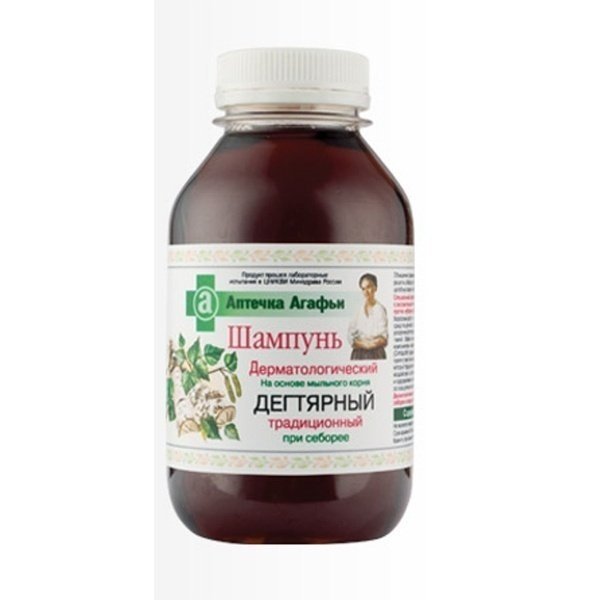
Tar from grandmother Agafya
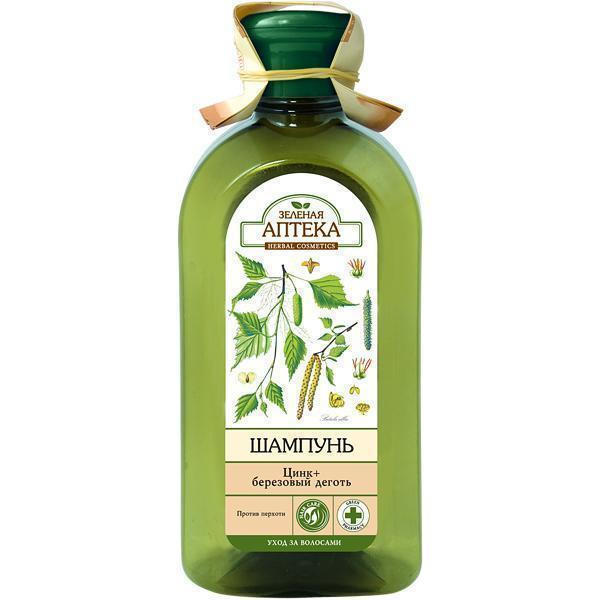
Zinc plus birch tar
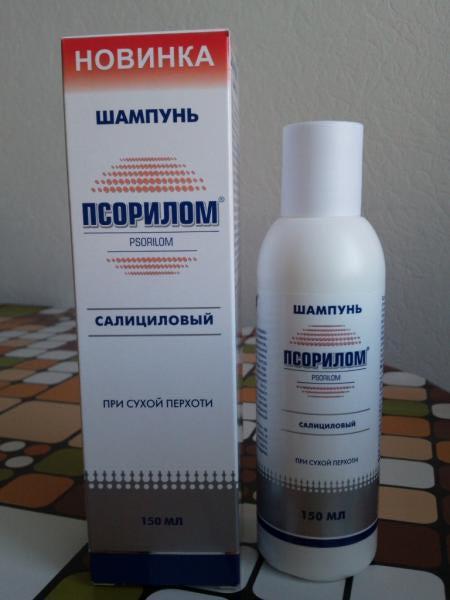
Psoril
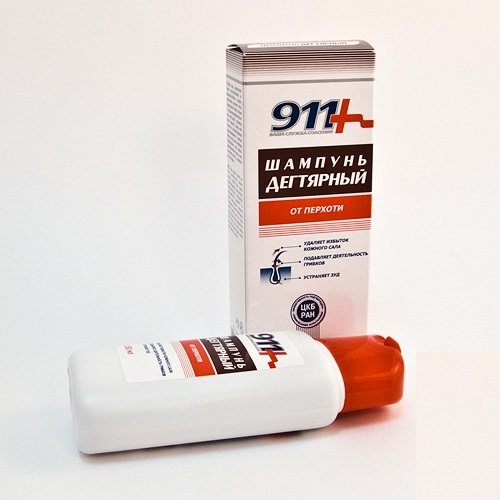
911 Tar
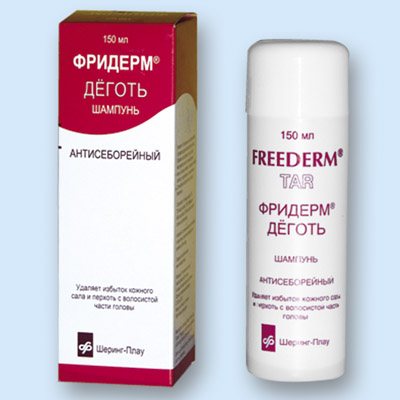
Friederm

Algopix
The results of using anti-psoriasis shampoos can only be assessed after a few weeks. Monitor your skin condition during use.
Effective healing masks
Aloe is a medicinal plant that is actively used to combat scalp psoriasis. 2 tbsp. l. medicinal juice is mixed with 1 tbsp. l. camphor alcohol, add birch tar (1 tbsp) and 1 chicken egg. Mix the ingredients thoroughly - you should get a mass of thick, homogeneous consistency.
Ready-made medicinal muds (they can be purchased at a pharmacy) help to cope with the manifestations of scalp psoriasis. Based on them, effective formulations are prepared at home:
- 1 tbsp. l. mud;
- 100 ml of chamomile decoction;
- 2-3 drops of liquid vitamin B.
Apply the finished mixture to the hair and scalp with gentle movements, and wash off the treatment mask with regular shampoo after 15 minutes.
A mixture of white clay and a decoction based on elecampane roots helps relieve itching, get rid of flaking and prevent further spread of rash on the scalp. Prepare the remedy as follows: 1 tbsp. l. The root of the plant (crushed) is placed in a thermos, poured with a glass of boiling water, and left to infuse for 3 hours.
Grind 1 onion and 2 garlic cloves in a blender, squeeze out the juice using gauze. 1 tbsp. l. This garlic-onion mixture is mixed with calendula decoction (150 ml) and 5-8 drops of tea tree oil and 1 chicken egg.
The resulting composition is evenly applied to the hair and scalp, washed off with decoctions based on medicinal plants - calendula, nettle, chamomile, etc.
Folk remedies aimed at treating psoriasis of the scalp generally do not cause adverse reactions, however, before using them on the affected areas, it is necessary to undergo an allergy test. To do this, you will need to apply a small dosage of the ingredients included in the recipe to your wrist and observe the reaction.
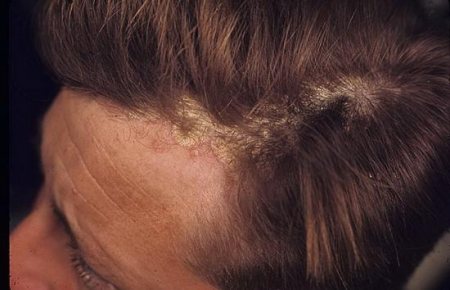
The use of the methods described below is prescribed not only to people suffering from psoriasis, but also to those who want to strengthen their hair, and use is possible not only during remission, but also during exacerbations of the disease:
- Water with soda. Baking soda is a product that softens the skin and relieves itching that occurs when the scalp is affected by psoriasis. To make the solution, you need to mix four teaspoons of water and one tablespoon of soda in one container. Rub the product into your head for a couple of minutes, then let it dry, then rinse.
- Aloe juice with garlic. Garlic is a plant that has antibacterial and antifungal effects. As a result of its use, the activity of lipoxygenase, an enzyme that is associated with inflammatory processes of the skin in psoriasis, is suppressed. You need to mix aloe juice and a few cloves of garlic, then apply to the affected areas of the head for 15 minutes and rinse.
- Castor oil. This product has a softening and nourishing effect on the skin. To achieve a positive effect, you need to rub a few drops of castor oil into the scalp at night.
Effective ointments are considered:
- Egg ointment. To make this ointment, you need to put a raw egg in a container and add 200 grams of vinegar. Let stand for 24 hours, then crush the egg along with the shell and add pork fat. The ointment is applied to the affected areas for no more than half an hour, after which the product must be washed off.
- Onion porridge. This product is made from grated onions. It should be applied to the head and cover the anointed areas with film or a warm towel. This process is performed to create a bath effect. After thirty minutes, you need to wash off the product without shampoo; next time you can wash your hair only after a day.
- The use of rose hips in folk medicine is believed to have a rapid and long-lasting effect in the treatment of scalp psoriasis. There are several recipes: ointment made from the ash of burnt rosehip branches (this product is mixed in equal proportions with medical petroleum jelly), rosehip ointment with an additional component - oak bark ash.
The following herbs are also used to treat scalp psoriasis:
- Celandine. This plant is actively used to treat psoriasis due to its healing properties: relieving the inflammatory process, rapid healing of wounds, and fighting microbes. However, when consumed internally, it is necessary to observe the dosage (for 1 glass, 1 tablespoon of celandine), if not followed, inflammation in the gastrointestinal tract may occur. Celandine also has the following contraindications: asthma, angina, pregnancy, epilepsy.
- Licorice. This plant can relieve inflammatory manifestations and improve metabolic processes, cleanse the patient’s skin and absorb harmful substances and toxins. Licorice has the following contraindications: kidney failure, hepatitis, liver cirrhosis, hypertension and diabetes of any type.
- A series. The plant helps relieve inflammatory processes and allergic reactions, and also effectively copes with microbes, cleanses the body as a whole and improves metabolism. The sequence is not recommended for use in the presence of diseases of the nervous system.
- Sage. This plant is actively used to treat psoriasis due to the presence of antibacterial and antifungal properties. Also, its use helps strengthen the immune system and relieve inflammatory processes. Sage should not be used in the following cases: in the presence of kidney and thyroid diseases, hypotension, during pregnancy and breastfeeding.
- Calendula flowers. This plant relieves inflammation and irritability, and also effectively copes with microbes. Taking calendula is contraindicated in combination with sedatives, as well as in the presence of the following diseases: hypotension, ulcers, heart disease and gastritis.
Prevention
Comprehensive treatment of psoriasis of the scalp involves constant adherence to all preventive measures. They will help reduce the frequency of relapses, as well as the severity of exacerbations. Try to adhere to the following rules:
- minimize stress and emotional turmoil;
- eat properly and fully;
- take vitamin complexes regularly;
- follow a special diet;
- stop smoking and drinking alcohol;
- use special shampoos regularly;
- limit your time in the open sun;
- Avoid visiting the solarium.
To reduce the frequency of relapses, you should pay special attention to your diet. Most of your diet should be given to protein and plant foods. Also, timely treatment of infectious and viral diseases will help prevent the development of this disease.

Diagnostic measures
Before prescribing a course of drug therapy to a patient, a dermatologist must carry out a series of diagnostic measures and differentiate the disease from other skin pathologies that have identical symptoms.
As a rule, during an appointment, a specialist performs the following range of actions:
- Damaged skin is examined.
- The patient's complaints are listened to and all external symptoms are determined.
- A pathological history is collected.
- Psoriatic scales are examined under a microscope.
- A biopsy is performed, after which the collected material is sent for histological examination.
- A laboratory blood test is ordered.
Every person who has encountered this disease and has undergone a course of drug therapy should regularly carry out preventive measures that can prevent relapses:
- Experts strongly recommend that this category of patients completely abandon all addictions, and especially the use of alcoholic beverages.
- Patients must observe the rules of personal hygiene, for which special means with a therapeutic effect should be used.
- From time to time, patients need to undergo vitamin therapy, for which vitamin and mineral complexes can be purchased at any pharmacy.
- It is recommended to adhere to a special diet throughout your life that excludes all harmful foods.
- People need to maintain a daily routine and find time for proper rest.
- It is recommended to minimize stressful situations that can trigger relapses.
- With regular contact with chemical environments, people must use personal protective equipment.
- It is necessary to promptly treat diseases of infectious, allergic and viral etiology.
Consequences
The most common consequence of scalp psoriasis is depression. The appearance of psychological problems against the background of aesthetic discomfort can occur in both women and men.
A person is forced to constantly hide his illness, because of this he begins to wear hats. Many people generally withdraw into themselves and stop going out into the world. A long course of the disease can cause social phobia.
Psoriasis is dangerous because it can easily spread to internal organs and joints. This occurs only in the absence of necessary treatment for a long time and in people with weakened immune systems. Often, due to psoriasis, bacterial infections enter the bloodstream and cause psoriatic hepatitis. Due to damage to the scalp, the risk of exacerbation of this disease in other parts of the body increases significantly. Timely treatment will help you recover quickly.
Stages of the disease
The disease affects the scalp, starting at the back of the head. It manifests itself as red spots and peeling with itching. But it can look different on the head depending on the degree of development:
- mild form of development. Foci of the disease are insignificant and rarely located. The inflammation is small. The plaques are covered with scales,
- severe form. The entire scalp is affected.
Stages of disease development:
- Progression. New plaques and patches of red, scaly plaques appear.
- Stationary stage. New lesions do not appear, but existing ones continue to bother the patient
- Regression. Gradual disappearance of affected lesions, plaques, redness, peeling and itching.
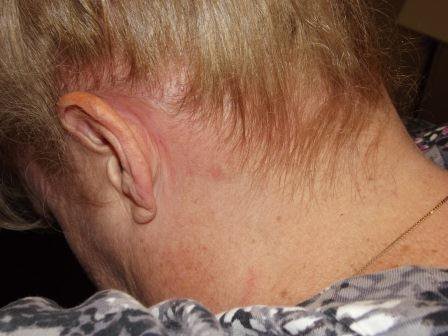
Psoriasis regression is characterized by the absence of plaques and indurations
